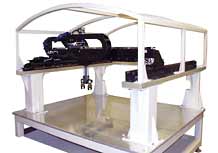
Cartesian Robots
Gradually good engineering raised its compelling head and more and more CARTESIAN robots were developed, so called after the mathematical co-ordinate system invented by the French mathematician and philosopher Rene Descartes in 1637. (Among his achievements was analytic geometry and the independent invention of calculus, whose better known independent inventor was Isaac Newton.)
A convenient way to describe vector motion components in Cartesian machines is north-south, east-west, and up-down for position, and roll, pitch, and yaw (from airplane language) for orientation. Very useful on the telephone. For the mathematically pure one says +- X, +- Y, +- Z, +- alpha, +-beta, +- gamma, and speaks learnedly of coordinate transformations. (To program a jointed arm, anthropomorphic, machine its computer must really perform coordinate transformations.)
One of the benefits of Cartesian robots is ease of programming. Since the linear axes are at right angles to each other there is no cross coupling. For point to point work with a small number of positions, limit switches and a very simple computer are all that are needed, typically a PLC. If many positions are needed, only a basic machine tool point to point numerical control system is needed. If continuous path motion is needed, a standard machine tool Computer-Numerical-Control will do. However if "teach mode" is needed for spray painting or the like (see Teach Mode below) there is no programming advantage.
A major benefit of Cartesian robots is the ability to make custom combinations of standard motion modules.
Another advantage of Cartesian robots is the ability to make a branched configuration having two or more independent motions and grippers. For example, one branch may remove a finished part while the other is picking up a fresh part.
A major advantage is the ability to provide very large working space. MOBOT made one robot with over 300 feet of motion along a row of machine tools and made several with 20 feet of vertical motion.
At MOBOT Corp. we designed and manufactured such non-anthropomorphic machines and sold them successfully for use in real factory jobs in major corporations, some in the computer industry. We generated credibility partly by de-bunking the hype about anthropomorphic robots.
